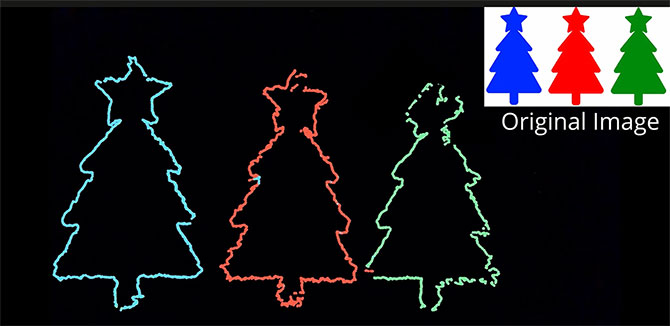Drones Bring Christmas to Campus
Kyle Wang’s MSR independent project featured a trio of drones painting a synchronized light picture of festive trees in the sky.

Kyle Wang (MSR ‘24) brought a springtime Christmas to the skies over Northwestern Engineering's Master of Science in Robotics (MSR) program.
Wang’s independent project used three synchronized drones to autonomously create a light painting – a trio of slowly traced Christmas trees that could be captured with long-exposure photography.
Wang created the drones’ control algorithm and the camera’s control interface. The project was designed so any image could be input, and the program would convert it into instructions for the drones.
“I was inspired by drone light shows,” Wang said of the increasingly popular form of entertainment featured in recent Independence Day and Olympics celebrations. He chose to work with three drones to make the project manageable yet still challenging in the 10-week timeframe.
The MSR independent project is a one-quarter opportunity for students to work on a standalone project. Wang worked to think through problems and solutions for his project as he spent 10 weeks learning to master the science of syncing multiple drones.
“Controlling one drone is hard,” he said. “There's always some sort of software or hardware issue, and the controls aren't perfect. Getting multiple robots to work together is much more challenging, since any of the robots can have issues.”
They had issues.
The amount of time needed to navigate through the hardware problems that kept the drones from doing what he wanted them to do surprised Wang. He wound his way through multiple glitches, including issues calibrating the drones’ positioning system and challenges keeping the trio connected throughout the slow-moving painting process.
Despite the challenges, Wang did not want to modify his plan.
“Although I could have completed my project using a single drone, using three at the same time made each light painting go by much faster,” he said. “In industry, the ability to have multiple robots work together means that tasks can be completed a lot quicker. A lot of processes can be automated, saving us time, energy, and in some cases, even eliminating safety concerns.”
Wang relied on lessons learned in MSR about programming, hardware, and sensor data to make the project a success. One takeaway from the experience was that sometimes it's better to program something yourself as opposed to trying to modify someone else's work.
"I used the ROS package built for these drones and ended up spending a lot of time trying to figure out how this package worked," he said. "I ended up making a lot of modifications to make it suit my project. Although it would have been more tedious, I think it would have been smarter for me to make my own package, rather than relying on someone else's. It would have been a lot easier to use for my project, since I could build in any functionality that I needed."
Wang keeps that lesson in mind as he prepares for his final MSR project, which will feature a swarm of 100 robots.
When he started his independent project, he wasn't set on his final project plans. All he knew was he was interested in the idea. That is a trait he believes is critical for this type of solo project.
"The most important thing is to choose something that you will enjoy,” he said. "Choosing a fun and interesting project makes it a lot more exciting and rewarding when you get it working."

